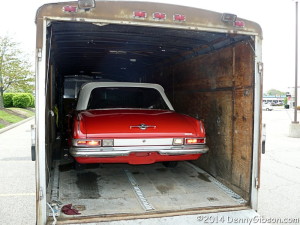 The Valiant departed this evening for its new home. I thought it would sell for a little more than it did, but I’m satisfied with the price and am much more than satisfied with the purchaser. Even though I claim no child or pet like emotional attachment to the car, it’s still nice to think it is off to a good home and that’s something the several telephone conversations I’ve had with the new owner have made me pretty certain of. Goodbye old girl, you’re going to have a much easier time traveling to Oklahoma than you did propelling yourself from there in July.
The Valiant departed this evening for its new home. I thought it would sell for a little more than it did, but I’m satisfied with the price and am much more than satisfied with the purchaser. Even though I claim no child or pet like emotional attachment to the car, it’s still nice to think it is off to a good home and that’s something the several telephone conversations I’ve had with the new owner have made me pretty certain of. Goodbye old girl, you’re going to have a much easier time traveling to Oklahoma than you did propelling yourself from there in July.
Tag Archives: Cars
Attention Shoppers
Valiant for sale
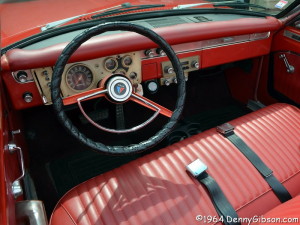 I’m using the blog this morning in an effort to make everyone within range of my keyboard aware that the Valiant I drove across the USA last summer is now listed for sale on eBay here.
I’m using the blog this morning in an effort to make everyone within range of my keyboard aware that the Valiant I drove across the USA last summer is now listed for sale on eBay here.
ADDENDUM 6-Feb-2024: The eBay listing resulted in the car being sold in April 2014.
My Wheels — Chapter 10
1964 Corvair
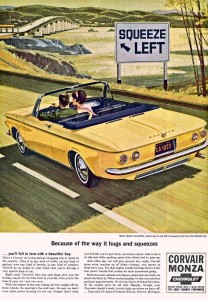 The replacement for the ten year old Austin Healey was a three year old one owner Corvair. I really can’t remember where the money came from for this major upgrade. Possibilities include a “distribution” from my grandparents like the one that enabled my sister and me to buy that 1959 Chevy or some money from my wife’s family. It is for certain, though, that we didn’t buy it with money saved from the wife’s secretarial earnings or my halftime co-op job.
The replacement for the ten year old Austin Healey was a three year old one owner Corvair. I really can’t remember where the money came from for this major upgrade. Possibilities include a “distribution” from my grandparents like the one that enabled my sister and me to buy that 1959 Chevy or some money from my wife’s family. It is for certain, though, that we didn’t buy it with money saved from the wife’s secretarial earnings or my halftime co-op job.
Our 1964 Monza, with 110 HP engine and 4 speed manual transmission, looked pretty much like the car in the ad at right. Although seat belts were showing up quite a bit in the first half of the 1960s, they were not required in new cars until the 1965 model year so that the double entendre of the ad was perfectly legit even if it was’t exactly responsible safety wise. The car remains one of my all time favorites. It looked great, was fun to drive, and even handled snow better than most cars of the day.
It’s tough to write more than a paragraph or two about the Corvair without mentioning Ralph Nader. There is a common misconception that Nader’s 1965 book, Unsafe at Any Speed, killed the Corvair. The marketplace killed the Corvair. Americans just were not ready to embrace the unconventional rear-engine design. On the other hand, Nader’s criticism of the car’s handling had some basis in fact. The earliest Corvairs had no front stabilizer bar. To compensate for most of the weight being in the rear, Chevrolet specified a huge difference between front and rear tire pressure (15 PSI front, 26 PSI rear). In practice, that unusual specification was probably not adhered to very well. It didn’t even apply to my car since, for the 1964 model, a front stabilizer bar and transverse-mounted rear spring were added. The suspension was completely redesigned for 1965.
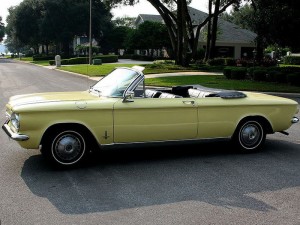 That’s not our car in the photo but, with the possible exception of that chrome trim around the gas lid, it could be. I believe we had the Corvair for about two years and during that time the incompatibility of our small and spotty paychecks with the need to eat and pay rent became rather clear. This was the car I drove to my first full time job and it was on the way to that job one morning that I tested the car’s crumple zones.
That’s not our car in the photo but, with the possible exception of that chrome trim around the gas lid, it could be. I believe we had the Corvair for about two years and during that time the incompatibility of our small and spotty paychecks with the need to eat and pay rent became rather clear. This was the car I drove to my first full time job and it was on the way to that job one morning that I tested the car’s crumple zones.
I was the third car on the I-75 entrance ramp when the lead car started to accelerate for the merge. I looked at the traffic on the expressway and decided there was a sufficient gap for all three of us. When I turned my attention back to where it should have been, I discovered that the lead car had decided that there wasn’t even enough room for one of us and stopped. Car #2 hit car #1 just a moment before car #3 (me) hit car #2. I don’t know if either of the other drivers was charged with any thing or who paid for their damage. I wasn’t and didn’t. After looking things over and talking to everyone, the policeman handed me a citation listing my offence as “having an accident”. There was no fine or other penalty and I was responsible only for the damage to my own car. That was enough.
The badly wrinkled car was soon sold. Normally that might be the end of the story but I sold this car to a friend and it wasn’t just any friend, the buyer was Dale, the lifelong buddy who has appeared in other posts including the Whizzer and the 4CV. I contacted Dale and got a bit of a memory refresher. The yellow Corvair made it to Darke County where it was fitted with the front end of a non-running green Corvair (1960 I think) that Dale already owned. The front end was painted to match and Dale drove the car to St Louis where he then lived. A blown head gasket revealed itself on the trip. “…about gassed us out”, Dale remembers. “Bad headache for a couple days.” In St Louis, he got a cylinder from a junkyard only to find that the replacement would not clear a crankshaft counterweight. So Dale, “with hacksaw in hand, made a relief in the cylinder and it worked.” Ah, those were the days.
Dale drove the car for quite awhile including a year or so around northern Indiana’s Fort Wayne. Dale’s green Corvair had a gas heater. There was a little burning odor and people looked at the car warily when they first heard the heater burning off excess gas after the engine was turned off but it sure worked good for keeping you warm. 1963 was the last year for the gas heater, even as an option, so the yellow ’64 had only “direct air” heat. Dale’s last comment on the yellow convertible sums it up pretty well, “Sure was a fun car but a crappy heater.”
Previous Wheels: Chapter 9 — 1965 Honda 65
Next Wheels: Chapter 11 — 1967 Dodge
Book Review
By Mopar to the Golden Gate
Denny Gibson
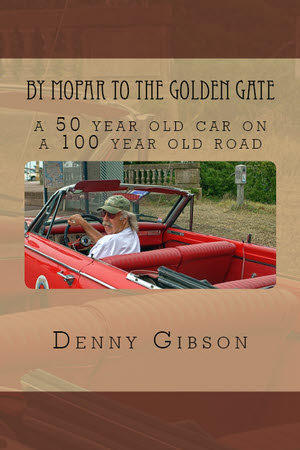 This book has thousands of words, many with multiple syllables, and dozens of pictures in 50+ shades of grey. It tells the story of an old man in an old car on an old road and is available here and at Amazon, including Amazon UK and Europe, on an old medium — paper.
This book has thousands of words, many with multiple syllables, and dozens of pictures in 50+ shades of grey. It tells the story of an old man in an old car on an old road and is available here and at Amazon, including Amazon UK and Europe, on an old medium — paper.
By Mopar to the Golden Gate, Denny Gibson, Trip Mouse Publishing, 2013, paperback, 9 x 6 inches, 140 pages, ISBN 978-0615921990.
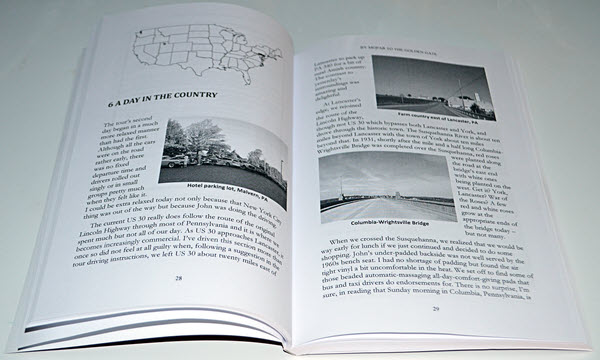
My Wheels — Chapter 8
1957 Austin Healey
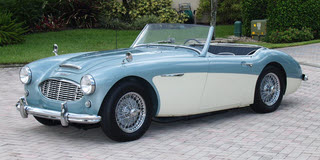 Why in the world would a couple of newly weds buy a ten year old British sports car in the middle of winter? I am, at present, as baffled as anyone though I apparently once knew the answer to that question. A month or so after our 1966 Boxing Day wedding, my bride and I purchased a 1957 Austin-Healey 100-6. The one pictured is a 1958 model but looks pretty much like our ’57. This was not a play car to park next to a dependable sedan. This was our only car.
Why in the world would a couple of newly weds buy a ten year old British sports car in the middle of winter? I am, at present, as baffled as anyone though I apparently once knew the answer to that question. A month or so after our 1966 Boxing Day wedding, my bride and I purchased a 1957 Austin-Healey 100-6. The one pictured is a 1958 model but looks pretty much like our ’57. This was not a play car to park next to a dependable sedan. This was our only car.
The Renault‘s reliability had steadily decreased until I sold it to a friend who either rebuilt or replaced the engine and drove it for quite awhile. I almost bought a 1959 Plymouth an aunt had recently replaced and actually “test drove” the car for a few weeks before acquiring the Healey. Buying the Plymouth would have been the sensible thing to do. But we were 18 and 19, I was a full time student, she was just out of high school, and we had just gotten married. Why spoil it by doing something sensible?
The Healey lasted more than a year. It was a great summer car and an OK winter car. Climbing snow covered Cincinnati hills was not its strong suit but it got around as good as many other cars of the day and it was reasonably warm in slowish city driving. Things were a little different on the open road. It helped that it had a removable hard top. It was fiberglass and not heavily insulated but was infinitely better than the cloth top. But it was a true roadster with sliding Plexiglas side curtains rather than roll up windows. At highway speed on a cold day, the heater stayed on full blast trying to keep up with the air escaping through the side curtains.
That soft top I mentioned was on the car once while I owned it. Attaching it had much more in common with raising a tent than with raising a convertible top. The hard top came off in the spring and went on in the fall. In between, with the one exception to prove that erecting the canvas top was possible, we made do with a tonneau cover and, yes, we did get wet now and then.
It was called a 2+2 with a pair of padded depressions in a shelf behind the seats. I actually remember carrying someone in those “seats” for a short distance but the shelf was much better at holding a couple bags of groceries than a couple derrieres.
The 100-6 was produced for three years. In 1956 it replaced the four-cylinder 100 which immediately became known as the 100-4. The 100-6 had a 2.6 liter six-cylinder engine and a four-speed transmission with overdrive. In 1959, it was replaced with the 2.9 liter Austin-Healey 3000 which had a rather long run through 1967.
Cars are often remembered for the misadventures they were part of and here is a story that helps me remember the Healey. For reasons not quite remembered, there was no license bracket on the front for awhile. It had been damaged somehow and repairing it had slipped entirely off my schedule. We were driving home after a visit to my parents. On state route 49, near the town of Arcanum, we passed a state trooper headed the other direction. He turned around, turned on his lights, and pulled us over. There was no “serious” issue, like speeding, but there was no front license. After checking a few things, he gave me a written warning and went on his way.
A couple of weeks later, I was back in Darke County. The low slung Healey had suffered a few scrapes and bumps on its crankcase and had developed a minor leak. I arranged to meet a high school buddy who had a welder so we — actually he — could fix the leak. The repair was accomplished and I headed home. At just about the same spot as before, that same state trooper passed the Healey with the same license plate not there. When I saw his brake lights come on, I immediately turned off on a side road and, with a few quick turns on the narrow roads, made my getaway. Satisfied that my evasive maneuvers had worked, I was starting to slow when I saw it. The road ahead was unpaved. It had not been graded for awhile. A fairly tall gravel ridge stood in its center. Before I could stop, I was plowing that gravel. Then I was oiling it.
The gravel had ripped off the recently applied weld and the crankcase was leaking much worse than it ever had before. I lost a lot of oil by the time I made it back to the main road. At a little gas station and grocery store, I bought a five gallon can of used oil. I believe farmers sometimes used used oil in slow reving equipment so it was often available for sale. The leak was not quite as bad as I feared but I still lost close to another gallon getting back to the friend’s house. He had just been visiting from college and was already gone when I got there. His dad let me use the welder and I managed to plug the leak with one of the ugliest welding jobs ever. This was the first and last time anyone ever left me alone with a welder. Then I drove home and fixed the license bracket the very next day.
Although our car must have looked just like the one in the picture when new, when we had it the paint had lost its shine and there was rust. Not major visible rust but hidden and interior rust in floor pans and such. The car was never garaged while we had it and I suspect that was true of much of its life. The rust and mechanical malaise led to the Austin-Healey being replaced before the next summer rolled around.
Previous Wheels: Chapter 7 — 1961 Renault 4CV
Next Wheels: Chapter 9 — Honda 65
Although this post is semi-random (I picked it from two possibilities) it appears during Cincinnati’s first snow event of the year (which is kinda why I picked it) and gives me an excuse to tell a semi-related story.
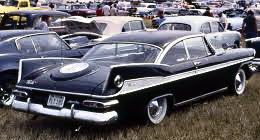 The 1959 Plymouth Fury at left is a dead ringer for the one I passed up to get the Austin-Healey. A rather spiffy ride, don’t you think? On one snowy night, my new wife and I were out with a friend in my borrowed car. The snow was not deep but the big Plymouth was not doing well on the slick streets. At one point, as we attempted to climb a slight incline, the friend and I got out to push while my wife took over driving. It did not take much to get the car moving but stopping to let us back in would have left the car stuck once again. Instead, my friend and I each grabbed a fin and “skied” alongside the Plymouth to the top of the hill.
The 1959 Plymouth Fury at left is a dead ringer for the one I passed up to get the Austin-Healey. A rather spiffy ride, don’t you think? On one snowy night, my new wife and I were out with a friend in my borrowed car. The snow was not deep but the big Plymouth was not doing well on the slick streets. At one point, as we attempted to climb a slight incline, the friend and I got out to push while my wife took over driving. It did not take much to get the car moving but stopping to let us back in would have left the car stuck once again. Instead, my friend and I each grabbed a fin and “skied” alongside the Plymouth to the top of the hill.
Valiant Still
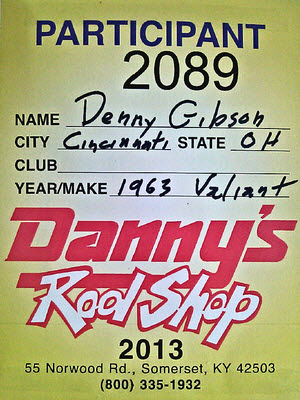 I made my first attempt to sell the Valiant this weekend. It was feeble and half-hearted and impressively unsuccessful. What I did was put the car on display in southwest Ohio’s largest car show with a “For Sale” sign on it. At the end of two days, I had not a single indication of serious interest in the car but I’m neither disappointed nor particularly surprised. The whole thing was something of an experiment and I think I learned quite a bit which is essentially what experiments are for. I certainly hope I no longer own the car when next year’s show rolls around but I’m pretty sure I could generate a little more interest if that were the case. I’ve got a somewhat better handle on the crowd and I’ve got a much better handle on pricing.
I made my first attempt to sell the Valiant this weekend. It was feeble and half-hearted and impressively unsuccessful. What I did was put the car on display in southwest Ohio’s largest car show with a “For Sale” sign on it. At the end of two days, I had not a single indication of serious interest in the car but I’m neither disappointed nor particularly surprised. The whole thing was something of an experiment and I think I learned quite a bit which is essentially what experiments are for. I certainly hope I no longer own the car when next year’s show rolls around but I’m pretty sure I could generate a little more interest if that were the case. I’ve got a somewhat better handle on the crowd and I’ve got a much better handle on pricing.
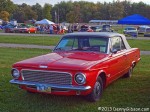 Danny’s Rod Shop is a key player and gets a ton of name exposure by supplying the window tags but the Pumpkin Run Nationals is managed by Fastiques Rod & Custom, Inc., a car club based in Owensville, Ohio. The show, which typically has 2600-2800 entries, is held in Owensville at the Clermont County Fairgrounds. This is their 38th year. I’ve attended before as a spectator but this was my first time as a participant. Cars must be running and registered and can be no newer than 1970. That’s it. Gates open at 6:30 Friday morning and cars are waiting. The picture of the Valiant was taken about 9:30. The place seems rather full by Friday afternoon but there is another burst on Saturday morning that makes the fairgrounds seem packed.
Danny’s Rod Shop is a key player and gets a ton of name exposure by supplying the window tags but the Pumpkin Run Nationals is managed by Fastiques Rod & Custom, Inc., a car club based in Owensville, Ohio. The show, which typically has 2600-2800 entries, is held in Owensville at the Clermont County Fairgrounds. This is their 38th year. I’ve attended before as a spectator but this was my first time as a participant. Cars must be running and registered and can be no newer than 1970. That’s it. Gates open at 6:30 Friday morning and cars are waiting. The picture of the Valiant was taken about 9:30. The place seems rather full by Friday afternoon but there is another burst on Saturday morning that makes the fairgrounds seem packed.
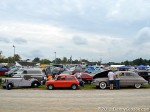 The picture at right hints at the variety of cars on display. That is an original MINI between the MG-TD and the big Packard. It is hard to identify specific cars beyond the three in the foreground but I do see a panel truck, a couple of Chevrolet hardtops from the sixties, a pickup truck, and at least one decades old sedan.
The picture at right hints at the variety of cars on display. That is an original MINI between the MG-TD and the big Packard. It is hard to identify specific cars beyond the three in the foreground but I do see a panel truck, a couple of Chevrolet hardtops from the sixties, a pickup truck, and at least one decades old sedan.
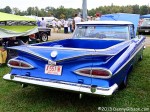
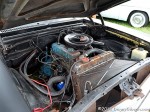
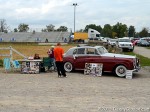 I picked these three as some of the more unusual stock cars I saw. The 1959 El Camino is beautiful as well as unusual. Then there’s a 1960s era Chevrolet 4-cylinder and a 1969 Rolls Royce.
I picked these three as some of the more unusual stock cars I saw. The 1959 El Camino is beautiful as well as unusual. Then there’s a 1960s era Chevrolet 4-cylinder and a 1969 Rolls Royce.
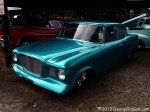
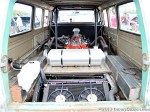
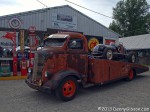 There is no shortage of variety but the Pumpkin Run is the brainchild of a hot rod club so there is a general air of performance. Among the stock entries, Muscle Cars are plentiful, and real drag and even track racers are well represented. The middle picture is of a Corvair window van based dragster with a big V8 where a bench seat once sat and electric fans where the original flat-6 once was. There were several Studebaker Lark based dragsters which I found surprising.
There is no shortage of variety but the Pumpkin Run is the brainchild of a hot rod club so there is a general air of performance. Among the stock entries, Muscle Cars are plentiful, and real drag and even track racers are well represented. The middle picture is of a Corvair window van based dragster with a big V8 where a bench seat once sat and electric fans where the original flat-6 once was. There were several Studebaker Lark based dragsters which I found surprising.
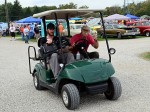 I happened to look inside that green Lark and noticed a message. Dennis Gage of the TV show My Classic Car was known to be on the grounds doing interviews and such for a show to be broadcast in January. Looks like one of those interviews just might be with the owner of the Lark. I ran across Dennis himself a bit later and got a friendly pose when I raised my camera. He was coming from the general vicinity of my car but I found no note on my front seat.
I happened to look inside that green Lark and noticed a message. Dennis Gage of the TV show My Classic Car was known to be on the grounds doing interviews and such for a show to be broadcast in January. Looks like one of those interviews just might be with the owner of the Lark. I ran across Dennis himself a bit later and got a friendly pose when I raised my camera. He was coming from the general vicinity of my car but I found no note on my front seat.
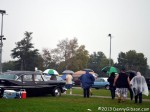
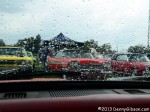 The weather on Friday was great and, although it rained a little overnight, Saturday started out just about as good. Then, a little before 2:00, some rain fell. It was short lived but so was the sunshine the followed it. Starting about 3:30, the rain became increasingly steady. I was one of the car owners who retreated to their vehicle and quite a few actually headed for the gate. That yellow car seen through my windshield is a Super Bee. There was another on my left side and a Road Runner a couple of cars beyond that. The rain wasn’t too heavy and the temperature remained high so people continued looking at cars but the numbers had definitely decreased. Anyone who had a poncho or umbrella, put it to use.
The weather on Friday was great and, although it rained a little overnight, Saturday started out just about as good. Then, a little before 2:00, some rain fell. It was short lived but so was the sunshine the followed it. Starting about 3:30, the rain became increasingly steady. I was one of the car owners who retreated to their vehicle and quite a few actually headed for the gate. That yellow car seen through my windshield is a Super Bee. There was another on my left side and a Road Runner a couple of cars beyond that. The rain wasn’t too heavy and the temperature remained high so people continued looking at cars but the numbers had definitely decreased. Anyone who had a poncho or umbrella, put it to use.
Weather reports called for a stop to precipitation around 5:00. I mostly stayed in the car until, at about a quarter until 5:00, I saw clearing skies approaching the fairgrounds. With predictions of storms and heavy rain overnight and a rather wet Sunday, I decided to truncate my first (and probably only) participation in the Pumpkin Run at two days. I headed home.
My Wheels — Chapter 7
1961 Renault 4CV
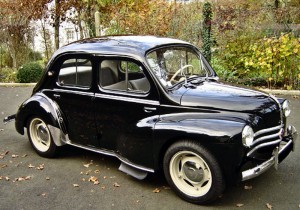 Having that long white Chevy convertible on campus sure was cool but I knew it was a fleeting thing. A high school buddy would also be attending college in Cincinnati when I returned for my sophomore year and the two of us decided to share an apartment somewhere between our two schools. This meant I needed, or at least could justify, a car but it wouldn’t be that lovely Impala. Reason number one, of course, was that I only owned half and there was no way I could afford to buy out my sister. Another was that, even at a quarter a gallon, feeding that V8 was a challenge for a perpetually broke college student. Sis bought all of the Chevy and I bought a semi-running 1961 Renault 4CV.
Having that long white Chevy convertible on campus sure was cool but I knew it was a fleeting thing. A high school buddy would also be attending college in Cincinnati when I returned for my sophomore year and the two of us decided to share an apartment somewhere between our two schools. This meant I needed, or at least could justify, a car but it wouldn’t be that lovely Impala. Reason number one, of course, was that I only owned half and there was no way I could afford to buy out my sister. Another was that, even at a quarter a gallon, feeding that V8 was a challenge for a perpetually broke college student. Sis bought all of the Chevy and I bought a semi-running 1961 Renault 4CV.
I bought it from a high school friend and I really wish I could remember how he came by it. This is not the sort of vehicle high school kids in rural Ohio typically lusted after. I got it cheap because of the semi-running part. The rings were pretty much shot and I doubted the small trunk would hold enough cans of oil to get me back to Cincinnati. I worked out a deal with a mechanic where I would do the grunt work and he would handle the finer points of installing new rings for a greatly reduced price. By mid summer I had a fine running five year old imported sedan.
Fine running is, of course, relative and so too, in some sense, is the five year old bit. Though this particular specimen was just five years old, the 4CV had been in production since 1947 with a design that started in 1941. The 4CV name comes from four taxable horsepower. Stateside, the earliest models were rated at 23 horsepower so I guess one French horse equals 5.75 American horses. My car was from the final year of production and benefited from all fourteen years of improvements. It had 28 American horses. The engine and 3-speed transmission were in the rear. First gear was unsynchronized and the floor mounted shifter made the one in a VW Beetle feel like a Hurst. Incidentally, the three previous My Wheels 3-speeds, ’53 Chevy, ’54 Merc, and ’52 Ford were also unsynchronized in first as was standard at the time. Twenty-eight horsepower and Cincinnati hills just made it a lot more memorable.
Memorable, in fact, is a great description of this car. I only owned it for six months or so but I’ve got a ton of memories. In Cincinnati, it quickly became known as Supercar because it was anything but. At 40+ miles per gallon and easily parked dimensions, it was a popular ride for small — absolute max of four — group outings. When coming to a stop and the mood was right, someone might shout “air brakes” which signaled those in the front to hold open the suicide doors to help slow the car. The gas tank held just over seven gallons. It was a time when gas stations often gave away drinking glasses and other premiums “with an 8 gallon fill-up”. (A few years later, graffiti at a campus construction site, written in two installments, read “Free Angela Davis”… “with an 8 gallon fill-up” but that’s another story.) Had the 4CV been more popular, there might have been a class action suit in there somewhere but, as it was, I never got a free glass with the Renault.
 The car pictured at the top of the article is not mine although it looks pretty much the same. About the only difference is the wheels and I’m going to use pictures of a car at the Lane Motor Museum in Nashville to talk about them and a few other items. My car had wheels like the one at left. A bolt in the center of the chrome hubcap held it in place to cover the three, yes three, lugs. A friend who sometimes borrowed the car eventually bought it and I can’t remember whether this story comes from before or after the transfer in ownership. In either case, he had a flat one night while driving the car near the UC campus. As he fumbled with the French jack a couple of football player types came by and simply held up the car while he changed the tire.
The car pictured at the top of the article is not mine although it looks pretty much the same. About the only difference is the wheels and I’m going to use pictures of a car at the Lane Motor Museum in Nashville to talk about them and a few other items. My car had wheels like the one at left. A bolt in the center of the chrome hubcap held it in place to cover the three, yes three, lugs. A friend who sometimes borrowed the car eventually bought it and I can’t remember whether this story comes from before or after the transfer in ownership. In either case, he had a flat one night while driving the car near the UC campus. As he fumbled with the French jack a couple of football player types came by and simply held up the car while he changed the tire.
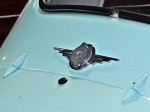
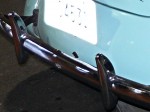 Zooming in on a couple of spots on the Lane car will help in describing some of the 4CV’s other unique features. Look closely at the bumper in the first picture. Notice that the hole in the bumper lines up perfectly with the hole in the body which lines up perfectly with the end of the engine’s crankshaft. Yep, a folding crank, possibly the same one that worked the jack, fit through those holes and could turn the engine. And yes, I did use it to start the car on occasion. In fact, I used it several times on one particular drive until I figured out that a short in a cable was draining the 6 volt battery.
Zooming in on a couple of spots on the Lane car will help in describing some of the 4CV’s other unique features. Look closely at the bumper in the first picture. Notice that the hole in the bumper lines up perfectly with the hole in the body which lines up perfectly with the end of the engine’s crankshaft. Yep, a folding crank, possibly the same one that worked the jack, fit through those holes and could turn the engine. And yes, I did use it to start the car on occasion. In fact, I used it several times on one particular drive until I figured out that a short in a cable was draining the 6 volt battery.
That’s a radiator cap in the middle of the chrome wings on the rear deck. The engine was water cooled. The climate control system consisted of a little door under the rear seat and a toggle switch on the dash. Opening the door and flipping the switch caused some air to be pushed through the opening. Since the air passed through the radiator, it was a few degrees above ambient and stayed that way for as much as an inch beyond the little door. Those French. What a great sense of humor.
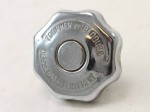 On the Lane car, the original cap has been replaced with a stamped metal one that actually looks like a radiator cap. The cap on my car was big and chrome and looked like the one at left. Full service gas stations were the norm but I had to be extremely careful with them to prevent my radiator being topped up with regular. The gas tank fill tube was inside the engine compartment. I once got a parking ticket on the OSU campus in Columbus. Since that big chrome radiator cap was the only thing on the outside of the car with any lettering, the ticket identified the vehicle make as Tourner et Bloquer.
On the Lane car, the original cap has been replaced with a stamped metal one that actually looks like a radiator cap. The cap on my car was big and chrome and looked like the one at left. Full service gas stations were the norm but I had to be extremely careful with them to prevent my radiator being topped up with regular. The gas tank fill tube was inside the engine compartment. I once got a parking ticket on the OSU campus in Columbus. Since that big chrome radiator cap was the only thing on the outside of the car with any lettering, the ticket identified the vehicle make as Tourner et Bloquer.
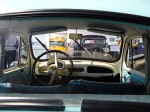 Here is one more picture of the Lane car taken through the rear window. The wipers are in their off position. The front windows actually rolled down though the rear ones just slid sideways to clear half of the framed area. My roommate and I once took a fairly long road trip in the Renault. By rearranging the rear seat and the front passenger’s seat, we made a “bed” where one of us could sleep while the other drove. In some now forgotten small Indiana town, I almost got a speeding ticket while Dale, my roommate, slept.
Here is one more picture of the Lane car taken through the rear window. The wipers are in their off position. The front windows actually rolled down though the rear ones just slid sideways to clear half of the framed area. My roommate and I once took a fairly long road trip in the Renault. By rearranging the rear seat and the front passenger’s seat, we made a “bed” where one of us could sleep while the other drove. In some now forgotten small Indiana town, I almost got a speeding ticket while Dale, my roommate, slept.
It was late at night and I had essentially passed through the town when the flashing light came on behind me. An uncle who spent a lifetime in law enforcement always advised getting out of the car if pulled over. The officer would feel safer if he could see you in the open with both hands visible. That always made sense to me but somewhere along the line it became just about the worse thing you can do. But it was still a good thing in 1966 and that’s what I did. The man in the car motioned for me to come back and get in the front seat beside him. He was an older fellow who wrote in a small lined notebook as he asked me where I was from, where I was going, and similar questions. When he learned that I lived in Cincinnati, he told me that he had once lived there, too. His family had moved away not long after the canal was closed down. That was, he thought he remembered, about the same time the buffalo nickle came out. (Both happened in 1913.) About that time he stopped writing and after a few more questions tore the page from the notebook and wadded it up. “Guess you won’t be coming through here again very soon”, he said. “No use giving you this ticket.” I’ve got a feeling that talking to me just made the old guy’s night go a little quicker and at the time I was certainly glad to move on without a ticket, even one handwritten on notebook paper. Looking back, though, it would be kind of cool to say I got a speeding ticket in a Renault 4CV. Can’t be many of those I bet.
Previous Wheels: Chapter 6 — 1959 Chevrolet
Next Wheels: Chapter 8 — 1957 Austin Healey
My Wheels — Chapter 6
1959 Chevrolet
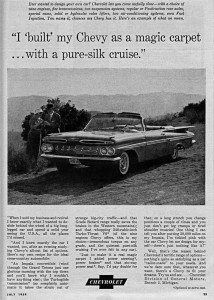 The advertisement at right is the fourth one on my wall and for the first time I really am talking about exactly the car pictured in the ad. The twist this time is that it was only half mine. My sister is almost exactly two years younger than me so she was turning sixteen when I was graduating. Having a car wasn’t quite as important for girls as for boys but it was still a good thing and that was especially true for kids, like us, living outside of town. We had each come into a few hundred dollars and I convinced her that we should combine resources and get a really cool car. We’d share it for the rest of the summer then, when I headed off for college in the fall, it would be all hers except for the occasional weekend when I came home for a visit. We looked at quite a few cars, including 1958 and ’59 four-passenger Thunderbirds, before settling on a white 1959 Impala convertible. I have the number $750 stuck in my head and I imagine that’s what we each contributed. It would have sold for something over $3500 when it was new and $1500 for the six-year-old car sounds about right.
The advertisement at right is the fourth one on my wall and for the first time I really am talking about exactly the car pictured in the ad. The twist this time is that it was only half mine. My sister is almost exactly two years younger than me so she was turning sixteen when I was graduating. Having a car wasn’t quite as important for girls as for boys but it was still a good thing and that was especially true for kids, like us, living outside of town. We had each come into a few hundred dollars and I convinced her that we should combine resources and get a really cool car. We’d share it for the rest of the summer then, when I headed off for college in the fall, it would be all hers except for the occasional weekend when I came home for a visit. We looked at quite a few cars, including 1958 and ’59 four-passenger Thunderbirds, before settling on a white 1959 Impala convertible. I have the number $750 stuck in my head and I imagine that’s what we each contributed. It would have sold for something over $3500 when it was new and $1500 for the six-year-old car sounds about right.
The 1959 Chevrolet is one of my all-time favorite automobiles and I really don’t believe it is because I once owned half of one. U.S. auto designers went crazy in the 1950s. Fins were in and they just kept getting taller until culminating in the towering blades on the 1959 Cadillac. Those ridiculous appendages are one of the most widely recognized automobile features ever and scream 1950s louder than almost anything else. The Chevy’s fins were no less extreme but, at least in my opinion, they had a lot more style. The Caddy was a fearsome projectile; The Chevy a graceful bird. Sorry. The prose is getting almost as silly as the fins but the truth is I like the smoothly arched fins that Chevrolet sported in 1959. The car looked like something an artist had created without constantly being told to get rid of these, add more of those, and straighten out that. The illusion was gone the next year. Horizontal wings were still around on the 1960 model but they were a crude caricature of those of ’59; Straight lines replaced the graceful arches and boring round lenses from the parts bin replaced the big red cat eye tail lights.
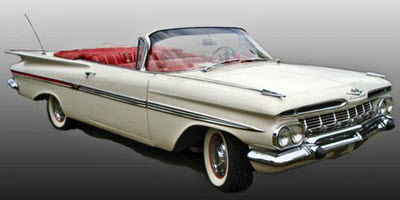 Getting back to my, I mean our, Chevy, you don’t have to imagine anything different from the car in the photo. That’s not our car but it could be. White with red interior and black top. 283 V8 with Powerglide automatic transmission. As we had planned, the car stayed with my sister while I lived in an on campus dormitory in Cincinnati — mostly. I did take the car with me for the last few weeks of the school year and I no doubt felt like one really cool dude. I don’t recall specific issues but the joint ownership thing came to an end that summer. For one thing, I decided I wanted a car with me for the next school year. I’m sure I didn’t have the money to buy out my sister and going with something that got a little better gas mileage seemed like a good idea. My sister became sole owner of the Impala but not its sole driver. I never did know all the details but there was at least one wreck when someone else was driving. I don’t believe the car was actually totaled but there was enough damage that the car went off to a new home.
Getting back to my, I mean our, Chevy, you don’t have to imagine anything different from the car in the photo. That’s not our car but it could be. White with red interior and black top. 283 V8 with Powerglide automatic transmission. As we had planned, the car stayed with my sister while I lived in an on campus dormitory in Cincinnati — mostly. I did take the car with me for the last few weeks of the school year and I no doubt felt like one really cool dude. I don’t recall specific issues but the joint ownership thing came to an end that summer. For one thing, I decided I wanted a car with me for the next school year. I’m sure I didn’t have the money to buy out my sister and going with something that got a little better gas mileage seemed like a good idea. My sister became sole owner of the Impala but not its sole driver. I never did know all the details but there was at least one wreck when someone else was driving. I don’t believe the car was actually totaled but there was enough damage that the car went off to a new home.
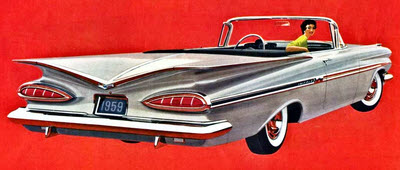 I’ve always liked this publicity picture. It emphasizes the car’s unique appearance and offers a hint at what it might be like in the front seat. I remember what it was like in the front seat. The hood was far from short — this was a full-size American cruiser — but it could seem that way by comparison with the rest of the car. With the top down, the view in the mirror was of a rear deck that reached to the horizon and extended all the way across it.
I’ve always liked this publicity picture. It emphasizes the car’s unique appearance and offers a hint at what it might be like in the front seat. I remember what it was like in the front seat. The hood was far from short — this was a full-size American cruiser — but it could seem that way by comparison with the rest of the car. With the top down, the view in the mirror was of a rear deck that reached to the horizon and extended all the way across it.
 ADDENDUM 1-Mar-2020: When this was originally posted, I had no pictures of the actual car, but now, thanks to my nieces, I do. The picture at right shows most of the car and all of my sister along with an unidentified K-9 companion. When I first saw the picture and noticed the small hubcaps, I thought I might have misremembered the car being an Impala. However, a little research indicates that all 1959 and 1960 Chevrolet convertibles were Impalas and not all had fancy full wheel covers.
ADDENDUM 1-Mar-2020: When this was originally posted, I had no pictures of the actual car, but now, thanks to my nieces, I do. The picture at right shows most of the car and all of my sister along with an unidentified K-9 companion. When I first saw the picture and noticed the small hubcaps, I thought I might have misremembered the car being an Impala. However, a little research indicates that all 1959 and 1960 Chevrolet convertibles were Impalas and not all had fancy full wheel covers.
Previous Wheels: Chapter 5 — 1952 Ford
Next Wheels: Chapter 7 — 1961 Renault 4CV
My Wheels — Chapter 5
1952 Ford
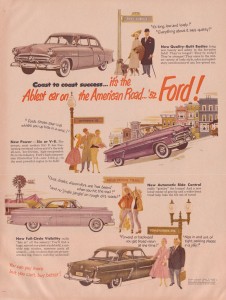 The fellow who drove my Mercury in that demolition derby was named Terry. He lived in the same town as my grandparents and had been a frequent passenger on the J. C. Higgins bicycle with the pseudo-fins on the carrier. When we got a little older, I was a frequent passenger on the back of his Zundapp motorcycle and we were both frequent passengers in each other’s cars. In Terry’s case that was a 1952 Ford.
The fellow who drove my Mercury in that demolition derby was named Terry. He lived in the same town as my grandparents and had been a frequent passenger on the J. C. Higgins bicycle with the pseudo-fins on the carrier. When we got a little older, I was a frequent passenger on the back of his Zundapp motorcycle and we were both frequent passengers in each other’s cars. In Terry’s case that was a 1952 Ford.
Through much of high school, Terry worked in a filling station pumping gas. He got paid a little money but we all know that the real reason was so he had a place to work on his car. Unlike me, Terry was meticulous. He rebuilt and repainted the flathead V8. He sanded and taped the car and worked out a deal to get it painted. He installed new seat covers and added seat belts; Not because they were required — they weren’t — but because they were cool and a good idea. He was pretty much at the end of his project list and had his sights on another car when the Mercury started worrying me a little. I don’t recall what it was that Terry replaced the Ford with but I replaced the Mercury with the Ford. This was the car I drove through my senior year and I think I may have sold it to the same guy I sold the Whizzer to. I’m not entirely sure of that but I do know it’s the car I loaned him when I went riding on the Whizzer the summer after graduation.
 Imagine the car in this picture with dark blue paint and baby moon hub caps and you’ll have something close to what I was driving in the spring of 1965. Besides two doors, it had dual two-barrels on an Offenhauser manifold, dual points in a Mallory distributor, and dual exhausts. It wasn’t particularly fast by 1965 standards but its description sounded fast.
Imagine the car in this picture with dark blue paint and baby moon hub caps and you’ll have something close to what I was driving in the spring of 1965. Besides two doors, it had dual two-barrels on an Offenhauser manifold, dual points in a Mallory distributor, and dual exhausts. It wasn’t particularly fast by 1965 standards but its description sounded fast.
Previous Wheels: Chapter 4 — 1954 Mercury
Next Wheels: Chapter 6 — 1959 Chevrolet
Bambulance Chasers
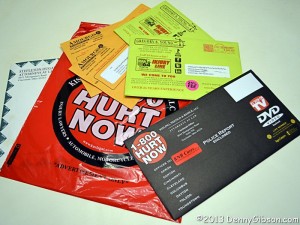 Since people who record logs on the web are “bloggers”, I’m thinking that those who chase ambulances on the web might be “bamulance chasers”. Of course, prior to Wednesday I didn’t even know they existed. Two days earlier I was in an accident. In stop-and-go traffic on I-71, I realized that the car in my rear view mirror was not going to make this particular stop in time. Bump to the back of me, crunch to the front, there I was. Stuck in the middle. The next car in line stopped in time but not the one after that. Five cars at the side of the expressway with varying degrees of damage but no injuries. The officer arrived. He collected a bunch of information from everyone, cited the guy that hit me, and sent us on our way.
Since people who record logs on the web are “bloggers”, I’m thinking that those who chase ambulances on the web might be “bamulance chasers”. Of course, prior to Wednesday I didn’t even know they existed. Two days earlier I was in an accident. In stop-and-go traffic on I-71, I realized that the car in my rear view mirror was not going to make this particular stop in time. Bump to the back of me, crunch to the front, there I was. Stuck in the middle. The next car in line stopped in time but not the one after that. Five cars at the side of the expressway with varying degrees of damage but no injuries. The officer arrived. He collected a bunch of information from everyone, cited the guy that hit me, and sent us on our way.
That was Monday. On Tuesday morning I spoke with the fellow’s insurance agent and made a Wednesday appointment for an estimate. The appointment was for 9:00 AM. At 8:07 my cell phone rang. It was a clue that I’d made a big mistake on Monday but I didn’t immediately figure that out.
The call was from the Collision Follow Up Agency or something along those lines. I answered a few questions, the call ended pleasantly, and I headed off to my appointment. Things went quite smoothly in getting the estimate started and getting a loaner car but I got another call while there. This time it was from the Follow Up Collision Agency or something along those lines and things finally clicked. I quickly informed the caller that there were no injuries in the accident and, as I now sort of expected, the interest diminished greatly. Thinking back, I could see that the same “no injuries” equals “no interest” exchange had occurred in the earlier call which I’d actually thought was from a legitimate government agency.
The back story also quickly became clear. I almost never answer my home phone unless I recognize the caller ID. Conversely, I almost always answer my cell phone because the only people with that number are people I’m actually given it to. At least that had been the case. Without thinking it through, I’d given the investigating police officer my cell phone number. It went on the police report which went on the internet Tuesday afternoon. I would get four more calls on Wednesday and two on Thursday for a total of eight. All were polite and none even hinted at a hard sell. One caller was more or less saying goodbye after a single word from me. He announced that he was from the Up Collision Follow Agency or something along those lines and I answered “OK”. There was a chuckle in my voice and he caught it.
“I guess I’m not the first”, he said.
“Nope. You’re fifth.”
For the sake of completeness, I volunteered that there were no injuries but I’m sure that wasn’t necessary. It was a short call.
Physical mail took a little longer. On Thursday, three pieces of accident related mail appeared. Two were duplicates except for my middle name being on one and not the other. Friday brought another matching pair. The black envelope was in the red bag which was hung on my door sometime Thursday.
The phone calls seem to have stopped with the two on Thursday. I left home before the mail arrived on Saturday so I don’t know if more solicitations are waiting in my mailbox. My impression is that the flurry is over. There are new police reports posted and other potential clients to call. Ambulance chasing may look a little different than it once did but it’s far from dead.
